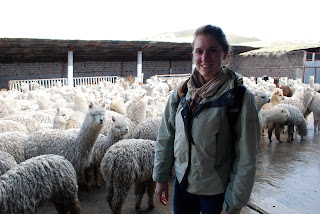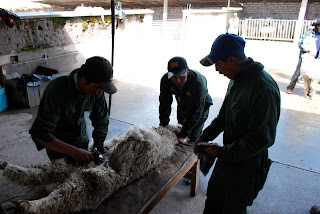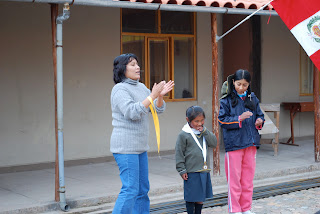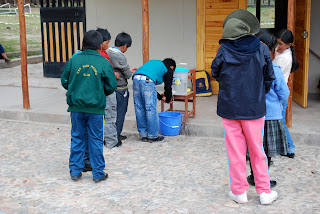March 14, 2012
Today was a fairly uneventful day because we made the trek back from the ranch to Cusco (roughly 7 hours). We did have some delicious food on our way though! And, we had the chance to shop a bit between Cusco and Puno! Tomorrow, we will begin touring Cusco. Until then, test your alpaca knowledge:
1. What is the name of a baby alpaca?
A. Perro
B. Cria
C. Gato
D. Foal
2. What is the average weight of an adult alpaca?
A. 100 pounds
B. 120 pounds
C. 140 pounds
D. 180 pounds
3. For how many months is an alpaca's pregnancy?
A. 11 months
B. 9 months
C. 7 months
D. 5 months
4. How many different kinds of alpacas are there?
A. 3
B. 13
C. 2
D. 19
5. Which of the following is not closely related to the other animals?
A. Vicuña
B. Alpaca
C. Sheep
D. Llama
6. Which country is home to the largest amount of alpacas?
A. United States of America
B. Chile
C. Argentina
D. Peru
Answers: 1. b. 2. c. 3. a. 4. c. 5. c. 6. d
-Leah
Thank you to the Douglass Cater Society of Junior Fellows at Washington College for supporting our trip!
Wednesday, March 14, 2012
March 13, 2012
The adventure contined today as we watched a herd of 1 year old alpacas have their first shearing. On Mallkini, the process is completed using an electric shearing tool and it takes only 2-3.5 minutes for each alpaca. On small farms, a number of hand shearing tools would be used and the process would be much longer.
Each alpaca produces around 2-3 kilograms per it's yearly shearing. Around the age of eight, the alpacas fiber production decreases substantially. After the alpacas are sheared, they look so, so much smaller than with their coats! Once the fiber is sheared, the fiber is seperated by fineness, packed into bags and eventually shipped to Arequipa where it will be separated further. Malkinu produces 50 tons of fiber (more or less) a year! The cria's fiber is typically very soft and one of the most prized fibers.
After the shearing an lunch, we visited the school again. The children were estatic to see us. We played volleyball during a recess period before visiting each classroom again. All the students drew pictures featuring the mountains, alpacas and other farm animals for us to take home. And each is beautiful. The third and fourth grade class was especially interested in us and asked us many questions. On boy asked me how old my father is... When I answered the ENTIRE class gasped! I wish I had it on film. Don't feel left out mom, they did the same for you! Another little boy asked Jesse and I if we had boyfriends and was heartbroken by our responses (how cute!).
Before leaving the school, we promised to stay in touch. The children are so beautiful and I hope the best for them. We asked what they want to be when they gro up and their answers included doctors, arcitects, chefs and teachers.
Tomorrow, we leave for Cusco. The majority of our Peruvian alpaca adventure is over and now we will be sightseeing.
-Leah
The adventure contined today as we watched a herd of 1 year old alpacas have their first shearing. On Mallkini, the process is completed using an electric shearing tool and it takes only 2-3.5 minutes for each alpaca. On small farms, a number of hand shearing tools would be used and the process would be much longer.
Each alpaca produces around 2-3 kilograms per it's yearly shearing. Around the age of eight, the alpacas fiber production decreases substantially. After the alpacas are sheared, they look so, so much smaller than with their coats! Once the fiber is sheared, the fiber is seperated by fineness, packed into bags and eventually shipped to Arequipa where it will be separated further. Malkinu produces 50 tons of fiber (more or less) a year! The cria's fiber is typically very soft and one of the most prized fibers.
After the shearing an lunch, we visited the school again. The children were estatic to see us. We played volleyball during a recess period before visiting each classroom again. All the students drew pictures featuring the mountains, alpacas and other farm animals for us to take home. And each is beautiful. The third and fourth grade class was especially interested in us and asked us many questions. On boy asked me how old my father is... When I answered the ENTIRE class gasped! I wish I had it on film. Don't feel left out mom, they did the same for you! Another little boy asked Jesse and I if we had boyfriends and was heartbroken by our responses (how cute!).
Before leaving the school, we promised to stay in touch. The children are so beautiful and I hope the best for them. We asked what they want to be when they gro up and their answers included doctors, arcitects, chefs and teachers.
Tomorrow, we leave for Cusco. The majority of our Peruvian alpaca adventure is over and now we will be sightseeing.
-Leah
Sheering
Llama crias
The best road block
Morning snow melting
Alpaca herd
Sheering time
Sheering time
Sheering time
Sheering time
Sheering time
Fiber from one alpaca
Alpaca fiber
Llamas
Fiber waiting to be shipped to Arequipa
Fiber waiting to be shipped to Arequipa
Two thumbs up
Alpacas by the guest house
Alpaca
Jesse, Cynthia and I
Vicuna
Washington College
Lunch
Recess at the school
Drawings by the children
Fifth and sixth graders
Third and fourth graders
Third and fourth graders
First and second graders
First and second graders
First and second graders
March 12, 2012
Today, Jesse and I visited the school sponsored by Mitchell & Co at Mallkini. The school hosts 22 girls and 19 boys ranging in age from 5 to 12. And, the children stay at the school from Monday to Friday before returning home to help their parents. Each day, the children are fed 3 nutritious meals, which helps to fight malnutrition. We joined the children for breakfast as they arrived to school for the first day of the week. We also had the opportunity to eat lunch at the school. It was the second time we ate alpaca!
The 41 children are divded by grade. There are three teachers who each teach two grades. First and second grade is in on classroom, third and fourth in another, and finally fifth and sixth in the last. Today was the first official day of the school year and one of the girls we met herding alpacas yesterday received an award for the highest grade from her class last year! The children were all very well behaved and participate in cleaning the dining room after eat meal.
After breakfast, Jesse and I acted as artists in the first and second grades, drawing horses, alpacas, cows, dogs and cats for the children! They were very exited to have us in te classroom. We also sat in on the other two classrooms as they started their studies.
After we ate lunch at the school, we returned to the Mallkini house and ate a second lunch... We were beyond full but everything is always delicious. We are very fortunate to have the opportunity to try so many Peruvian dishes, dessert included!
In the evening we met with the Mallkini staff to learn more about alpacas. There are two types: huacayo and suri and on average, fully grown alpacas weigh 140 lbs. We also talked about the economics of alpaca farming in Peru. Mallkini has 4,000 alpacas and the largest alpaca farm in the country has 60,000 alpacas! But, 80 percent of all pervian alpacas can be found on small farms, 100 alpacas or less. Small farms do not earn much profit from alpaca farming, often only enough to survive. In general, the alpaca fiber price is set my the demand in the international markets (particularly European fasion houses and their demand for the product).
Tomorrow, we will dive into the first step of exporting fiber: shearing. I am very excited to see the process!
-Leah
Mallkini (view from our room)
Awards at School
The students washing their hands before class
Girls dorm
First Graders
First Graders
Lunch at school (alpaca!)
Dessert at Mallkini (lunch)
Dessert at Mallkini (dinner)
March 11, 2012
Wow, what an adventure the past day has been! Jesse and I arrived to Mallkini Alpaca ranch yesterday around 2 pm and the first 24 hours on the ranch have been magnificent.
We arrived to the ranch after a 7 hour drive from Cusco... but the scenery and sights made the journey very enjoyable, as did one of our guides, Patrick, who shared with us much local knowledge. We had the pleasure of stopping between Cusco and Puno where many Peruvian women sell their goods. And of course, we are excited to stop on our journey back to help support the local market. Throughout the drive we also saw many small towns and substinence farmers. Because it was Saturday, many people were bringing their animals (sheep, cows, llamas) to the market.
When we arrived to the ranch we were greeted by the manager of the ranch Moises and enjoyed a delicious hot meal of beef, rice and vegetables (all the meals have been delicious!). Our driver and Patrick joined us for lunch before thy returned to Cusco leaving Jesse, Cynthia (our translator) and I to enjoy the next four days together. After lunch, we had the pleasure of walking around the ranch and seeing some of the 4,000 alpacas. We learned much throughout the walk from our host and the ranch vet. Before dinner, Moises shared with us the history of Mallkini. Mallkini has a rich history and today us owned by Mitchell & Co, the world's leading producer and exporter of Alpaca fibre products. Mallkini is the largest privately owned Alpaca operation on the Altiplato and has both Huacayo and Suri Alpacas. The ranch is manager by Moises and his son. In addition to alpaca farming and breeding, Mallkini invests in the local farmers and their families. In addition to providing local farmers education on alpaca breedig and health, Mitchell initiated a social program at Mallkini. The Mirasol Project was initiated in 2006 and started fully running as a boarding house and school in 2009. The program provides the children of alpaca farmers a goodschool and proper nutrition.
After a delicious dinner, Jesse and I were beyond exhausted from our travel days and went to bed around 9 pm so we would be well rested for our 8 am horse backing adventure throughout the 9,000 acres of Mallkini in the Andes. What a beautiful, spectacular trip!
We left the ranch by 8:30 and set off to visit some of the different herds of alpacas. In Mallkini there are 9 herds each consisting of 250 to 500 alpacas. We were led by the vet, Carlos, and our translator, Cynthia, came too. We set off with four horses and a foal (one of the horses was it's mother). Given I only rode a horse once in my life, I was very, very nervous but also excited. Jesse has ridden horses her entire life, so she was a pro! I was nervous for probably the first hour and a half... Until we climbed a steep mountain (that even made Jesse nervous) and I realized my horse really knew what he was doing! The sights were absolutely breathtaking! it was so, so amazing, the pictures don't do it justice an they're also amazing (see below).
The first herd we visited was all female alpacas and some llamas. Both the alpacas and llamas had some crias (babies). And we had the chance to meet the person watching and taking care of the herd. She was a 6 year old girl. Could you believe that?! And she knew exactly what to do with the hundreds of animals. When we were chatting, she excused herself to herd some of the alpacas and llamas closer to the group. Sure enough, moments later 25 alpacas and llamas cam running towards the others.
We met 3 girls at the next herd. The herd was entirely female alpacas and their crias. Here, we had the opportunity to pet a cria after the 11 year old caught it to show us. The girl was watching the herd with her two younger sisters for the weekend while their parents went to town. During the week, the girls attend the school at Mallkini. What amazing little girls!
Upon arriving back to the ranch around 1 pm (4.5 hours later) we had a delicious lunch (do you sense a pattern?all the food is delicious!) and finally a hot shower! in the evening, we met with Moises, the manager, Carlos, the vet and Daniel, a genetics expert to talk about alpacas... There is so much to know!
FUN ALPACA FACTS:
- Llamas, alpacas and vicuñas are all in the same family. The main differences are their size and fiber quality.
- Female alpacas are pregnant for 11 months before giving birth to one cria.
- Alpacas typically live for 18 to 20 years.
Enjoy the photos!
-Leah
sights from on the way to the ranch
sights from on the way to the ranch
our van
cusco-puno divide
cusco-puno divide
view from porch outside our room
view from porch outside our room
our room
Jesse and I with Patrick, guide to ranch
Alpacas!
Alpacas!
Alpacas!
Mallkini Guest House
Ready to go horse back riding
Ready to go horse back riding
Ready to go horse back riding
Horse back riding
Herd 1
Herd 1
Alpaca Cria
Llama
Alpaca
Jesse with an alpaca
Me and an alpaca
6 year old shepherding the herd
6 year old shepherding the herd
6 year old shepherding the herd
View from the mountains
Horse back riding
Cria
Cria
Jesse, Cynthia and I with the three girls
Horses taking a break
1 week old cria
Another herd
Lunch!
Subscribe to:
Comments (Atom)











































































